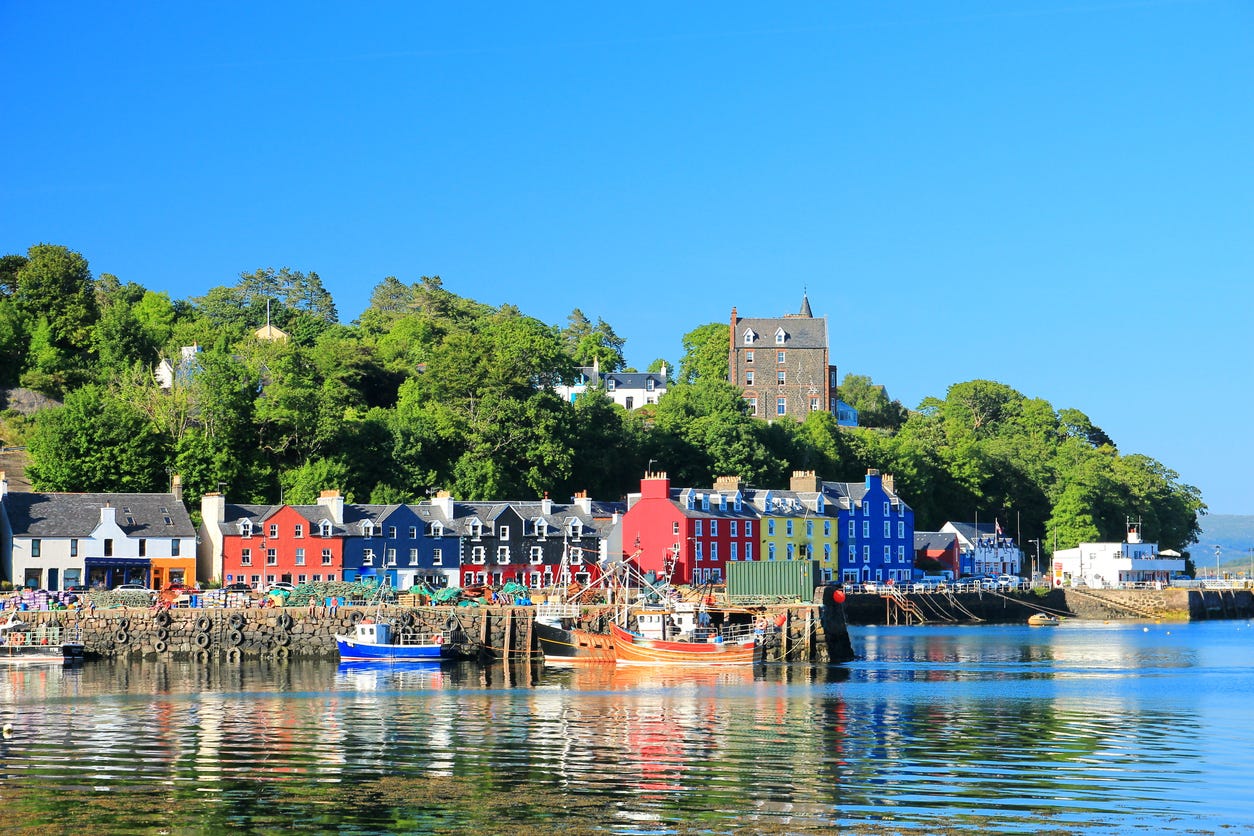Highland Romance on a Budget: Our 6 Weeks in Scotland’s Most Magical Stays
How we paired luxury lodgings with local feasts and wild experiences across northwest Scotland — all on a mid-range budget.

Ah, the wild Scottish Highlands! Misty mountains, endless moors, ruined castles, hillsides of purple heather. I love this kind of wilderness, and am prepared for some hardship for the experience of it.
Teresa (my beloved spouse), however, drives a hard bargain with nature: She loves the wilderness as much as I do, but prefers to view it through the windows of a luxury lodge. Teresa especially digs refurbished historic buildings that have been converted to sumptuous guest houses.
"But we can’t do this on a hotel budget of $200-$300 a night, can we?" I asked, while we were in the throes of planning our adventure. "Challenge accepted," Teresa replied with alacrity.
And so, although we stayed in various mid-range hotels, Airbnbs, cottages, and guest houses during our six-week Highland fling through northwest Scotland, we also found a handful of incredible, unique, affordable accommodations in some of the most remote parts of the country.
We would like to share with you our top four, each paired with our favorite nearby restaurant and local adventure.
The Albannach B&B: Lochinver, Assynt
" 200-year-old Highland home on the edge of the vast Assynt wilderness."
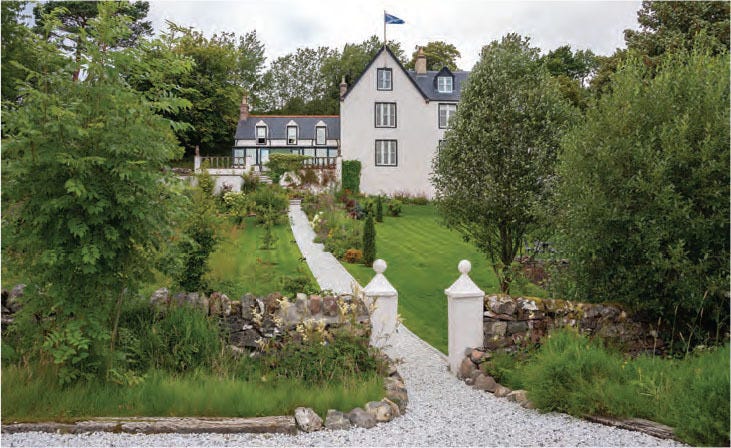
Lochinver is a tiny fishing town in the shadow of the five great mountains of Assynt.
Once, this vast wilderness area was the Laird of Assynt’s playground; his noble lineage hunted red deer in the hills and fished for salmon in the Inver River. The deer and salmon are still here, but the lairds are long gone. South Assynt is now a crofters’ collective in the hands of the peasant farmers who once tilled the laird’s farms and minded his sheep, while North Assynt has become a community-owned conservation area filled with peat bogs, lochs, forests, rocky coves, and geological wonders. It’s a hiker’s paradise.
Teresa squealed with delight when we turned up the long drive to the Albannach B&B. We climbed a gentle slope up a long green lawn, past gardens bursting with pink and purple flowers, eventually reaching a brilliant white house with a grey slate roof. The new owners, Robin Macgregor and Ballal Mirza, have fully restored the 19th century country manor, breathing new life into the old stone building.
When we opened the door to our separate little cottage to the side of the main house, Teresa fairly threw herself into the room. She looked around at the forest green wallpaper, crisp ironed linen sheets, the ornate Japanese headboard decorated with white cranes and cherry blossoms, and announced, "I am never leaving this room!" I laughed.
"You don’t understand," she flashed her big brown eyes at me. "This room is my spirit animal!"
I left my beloved to revel in the room while I explored the little pathway out of our private back door. It led to a neatly mowed hilltop with a bench and a stunning view of the loch and the village, with the great sugarloaf hump of Mount Suilven towering in the distance.
Over breakfast the next morning—an extensive menu of options cooked by Ballal—we got a chance to know our hosts better. They told us that before coming to Lochinver, they had owned and run a five-star hotel farther south, with a restaurant that soon earned the only Michelin Star in the Highlands. Their place was a massive success, but they could never take a day off, and eventually, it got to be too much for them. So, they decided to sell the hotel, buy the Albannach, and run it as a three-suite B&B—with plans to eventually make this their home in retirement.
Ah, this explained why the Albannach felt so sumptuous and cozy, as if it were enveloping us with its warmth. This was a B&B hand-crafted to be a home—a home for two people in love who share a deep sense of beauty. Shortly after they bought the property, the pandemic hit—which while bad for business, gave the two more than a year to work on restoring the house and gardens themselves.
As the other guests had all checked out the previous morning, Robin and Ballal showed us the suites, each one uniquely designed with care and meticulous attention to detail. Ballal’s Pakistani heritage provided exotic and whimsical touches that recalled the days of the British Raj: a ferocious portrait of a tiger in the stairwell, a playful statue of an elephant in the breakfast sunroom…
Kylesku Hotel Restaurant: Lochinver’s food scene is a bit sparse for a town that’s a tourist hub. Our best meal in the area was actually about an hour’s drive north at the Kylesku Hotel, in Sutherland on the shores of Loch Glencoul, which has an outstanding seafood restaurant. I ate the freshest, juiciest mussels of my entire life there, and no wonder—they are farmed nearby on long cords that dangle into the salt water along the side of the loch.
While farmed Scottish salmon takes a toll on the lochs that hold them— spreading fish waste, antibiotics, and disease—farmed mussels actually improve water quality, because as the mussels feed on plankton, they filter out impurities in the water. The restaurant also has fresh fish and chips, oysters, shrimp, and scallops supplied right off the boat by local fishers.
Kylesku Boat Tours: Just across from the restaurant is a dock that hosts Kylesku Boat Tours. A single bright red boat operated by Captain Michael takes passengers on a three-hour tour to the far end of the loch to see the highest waterfall in all of the British Isles. Eas a’ Chual Aluinn, which is Gaelic for "The Waterfall of the Beautiful Tresses," is three times as high as Niagara Falls. The water gushes out sideways like a geyser through a hole in the mountainside and cascades down to the loch surrounded by an empty wilderness. Along the journey, we spied stags on the hills, seals in the water, and searched in vain for sea eagles in the sky.
The Brochs of Coigach: Achiltibuie, Coigach
"Iron Age roundhouses in a modern context. Outside, they are raw like uncut gems; inside, they’re luxurious, airy, and light."
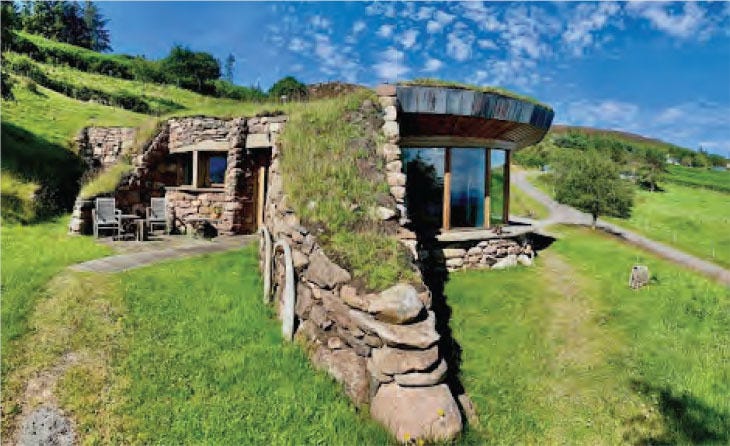
From Lochinver, a single-lane track winds south through the rugged hills of Assynt into the coastal mountains of Coigach. Locals call this the "wee mad road." It’s not for the faint of heart. It took me about 90 minutes to drive to the village of Achiltibuie, only 18 miles away—allowing for a traffic jam of cattle on the road and various sheep crossings—plus we pulled over a few times to simply soak in the stunning views of the green glacier-swept valleys. (One can also take a longer route on a better highway—recommended for first time drivers in the Highlands.)
At Achiltibuie we stayed in a modern incarnation of an Iron Age broch, a round house built of fitted stone. Unique to Scotland, some 541 ancient brochs dated some 2,000-2,600 years ago have been discovered all across the Highlands. I love archeology, and I have wandered about many excavated brochs, so the thought of living in a modern version of one for a week absolutely thrilled me.
Our nouveau-broch was utterly gorgeous, inside and out. It was spacious, clean, and very cozy. The owners, Reiner and Sheilagh Luyken, definitely improved on the Iron Age original. The exterior walls are fitted stone, and the floor plan is still circular. But there’s a wide bay window that gives a full 180-degree-view of Loch Broom—one of the largest sea lochs in Scotland. Instead of farm animals in the basement, electric underfloor heating kept us warm on cold nights. And they’ve added a fully modern bathroom, sauna, and kitchen.
While not luxuriously furnished—in fact the place struck us as a little spartan, given its size—the broch was all about the architecture. I was entranced by how they used a steel central pillar as the main support structure to create a spacious interior. Outside, a natural grass roof provided insulation and made the broch seem to flow seamlessly into the landscape. From the road above, it was all but invisible.
For their efforts, Reiner and Sheilagh received a 5-star rating by VisitScotland and a Gold standard of the Green Tourism Business Scheme. They were shortlisted for two prestigious architecture awards, and the German travel magazine Merian named The Brochs of Coigach as one of the "100 Best Dream Destinations for Two in the World."
Heedless of these prestigious honors, sheep and rabbits gamboled in the field outside our bay window each day, joined in the evenings by wild deer. In the long summer evenings the light was different from night to night. Sometimes Loch Broom would glow like a sparkling sapphire. Nearer dusk, the mountains beyond the loch would turn deep purple. Sometimes the clouds would reflect hot pink from the setting sun. Once, a full moon rose over the still water, leaving a streak of silver on its dark surface, like a shining inverted exclamation mark. We felt truly immersed in nature.
"There’s no need for internet here," I said to Teresa (though our wifi in fact worked just fine). "Our windows have the best streaming service in the world."
Summer Isles Hotel Restaurant: You might well suppose that in a remote place like this there would be little civilization to rely on. Indeed, the nearest town, Ullapool, is a forty-minute drive away. But Achiltibuie has a gas station, a decent if tiny grocery store that stocks French wine, and an amazing restaurant in the Summer Isles Hotel, just a ten-minute drive from our broch. With a full view of Loch Broom from the dining room, it’s a popular place; one needs to make reservations in advance (unless you want to eat in the informal bar area).
Teresa claims the fresh oysters she had as an appetizer were the best she had in her life. For mains we both ordered "Highland venison cooked over coals with wild mushrooms, neeps, and tatties" (turnips and potatoes). The meal came with a wine-colored forest berry sauce that enhanced the venison perfectly, and was different from any gravy I have ever tasted.
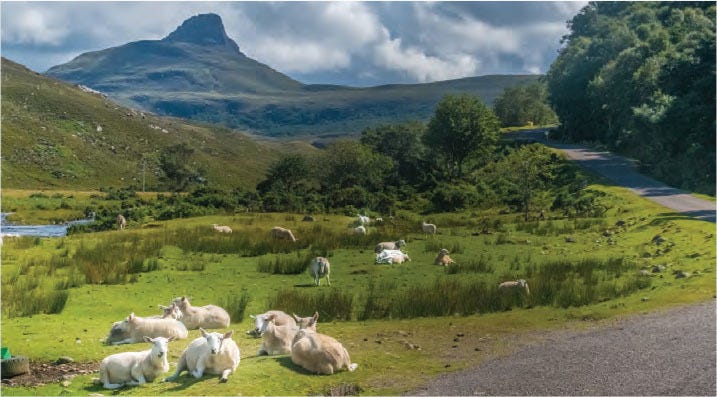
Knockan Crag Geopark: My favorite adventure in this area was a visit to the Knockan Crag National Nature Reserve Geopark. It’s a geology museum and a mountain hike combined into one! I couldn’t understand why Teresa chose to give it a miss. What’s thrilling to me is that this was the site that helped resolve one of the biggest geological mysteries of the 19th century, known as the "Highland Controversy."
In short, at that time geologists believed layers of rock were laid down in orderly succession, the oldest at the bottom, the youngest at the top. But early surveyors in the Highlands found troubling evidence of older layers on top of younger layers. Knockan Crag provided proof that this was so, and from these rocks, geologists began to piece together a very different view of the forces that shaped the planet’s surface—tectonic forces that caused continents to drift and collide, so that in places older layers of rock were thrust up over younger ones.
At Knockan Crag you can see these inverted strata of rock for yourself, and place your hands on one spot where the upper layer of grey gneiss is 800 million years older than the younger, yellow sandstone below. Placards tell the story of the controversy and how this remote place helped change science’s understanding of how the earth was formed.
The Black Castle of Barcaldine: Oban, Argyll
"A warm welcome awaits you in the beautiful surroundings of Argyll’s only ancient castle bed and breakfast."
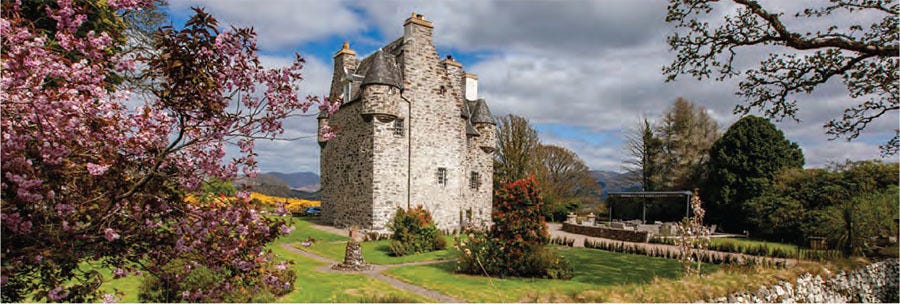
Teresa’s ultimate goal for our trip (it would not be wrong to call it a life ambition) was to spend a night in a Scottish castle. Not in a posh 19th-century mansion fancifully castellated to look like a some Victorian’s romantic idea of a castle. Teresa wanted to stay in a real medieval fortress, with thick rock walls. A place built for withstanding sieges and waging battle… but with lavishly redone interiors and ensuite bathrooms and a cocktail bar.
To me, that seemed a drawbridge too far. Frankly, I doubted that kind of fantasy existed in all of Scotland. But damned if Teresa didn’t find us the Black Castle of Barcaldine B&B in Argyll — the region northwest of Glasgow. It is the only inhabited medieval castle in all of Argyll.
As we pulled into the gate, the imposing Black Castle seemed to tower over us like a stone giant, rasping "Halt! Who dares to enter!" Though actually, when we rang the bell, a voice responded "Welcome to Barcaldine" with a friendly Glaswegian accent.
Simon, the manager, was indeed from Glasgow. He told us something of the history of the castle as he checked us in, and then gave us a tour. First, he invited us to notice the stone walls, a good two meters thick. He pointed out the thin slits in the stone through which one could point a gun without being shot.
Inside, the first thing we saw was the incredible 400-year-old stone spiral staircase (we were thankful for the rope that ran up the center of the spiral and gave us something to hang on to).
Simon showed us into the great hall, which took up the entire second floor. Since the castle had been abandoned for over a hundred years, this room had been entirely rebuilt in the style of a Victorian-era hunting lodge, complete with obligatory antlers and overstuffed leather furniture gleaming in the afternoon light. Simon told us that this room had not one, but two secret passages.
"Do you think you can find one of them?" he challenged us.
Teresa marched straight over to one of the wooden wall panels and gave it a push—it opened immediately, revealing a hidden staircase behind it. I was flabbergasted. Simon looked bemused. But really, this was not surprising. Teresa has read pretty much every British detective novel ever written, from Sherlock Holmes on down. I later asked her how she figured it out.
"Well, architecturally, a hidden door would have to be in one of the panels, and logically the back wall by the window was the most likely place. Looking in that direction, I immediately noticed a little gap in the moulding. It was obviously the crack of a doorway. It was just… elementary," she said, puffing her pipe and adjusting her deerstalker hat (well, figuratively speaking).
The castle’s upper two floors had been redone to make six bedrooms instead of the original three . Simon led the way up to our room. The door opened. Teresa gasped. The bed was a heavy wood four-poster—perfect for the place—but the real star of the room was the turret.. The entrance to this alcove was covered by a tartan curtain, behind which was a little round room with two windows facing nearby Loch Creran. Between them stood a small vanity desk and mirror, the sight of which utterly thrilled my beloved.
"From now on I only, ever, and always want to stay in rooms with a turret!" Teresa announced.
I left Teresa to bask in her turret-ecstasy, and went down to the ground floor to look at the old castle photos and artifacts on display in their mini museum. Barcaldine Castle was built in 1609 by "Black" Duncan Campbell, the 7th Laird of Glenorchy. The museum paints a grim picture of why both the laird and his castle were called "Black." Duncan’s several castles not only had dungeons, one also came complete with a "beheading pit" and another had a "hanging tree" on the grounds.
Those were bloody times in Scotland, and part of that bloody legacy is that Barcaldine has the reputation of being the most haunted castle in Scotland, featuring not one, but two ghosts that sometimes unsettle the guests.
Waterfront Fishouse Restaurant: Though a hearty gourmet breakfast is included at the castle, there’s not much by way of local dining. So we drove to the nearby port town of Oban—a large enough town that there are dozens of options. We chose the Waterfront Fishouse Restaurant. To be honest, we were kind of tired of fresh local fish at this point in our journey, but the Fishouse surprised us with fresh takes on classic dishes, like crab-and-pigcheek tacos, smoked haddock chowder, and roasted scallops with black pudding. The food was so good, and so surprisingly affordable, that despite the multitude of dining options, we came back to the Fishouse twice.
Glencoe Mountain Chairlift: In the afternoon we drove to nearby Glencoe, by all accounts the most beautiful valley in Scotland. The road does get crowded, though. The viewpoint parking lots are usually jammed, and the peaks, though enticing, are a pretty tough slog to reach by foot. Wondrously, however, there is a chairlift at the top end of the valley. In winter it’s a ski lift; the rest of the year it offers a leg up for lazy hikers who want to enjoy one of the most spectacular views in the Highlands without breaking a sweat, all for a scant 17 pounds ($20.80 USD) per person. We also discovered a ‘frisbee golf‘ course at the top, and one of the most whimsical outdoor art installations I have ever encountered: A solitary black doorway that stands like a portal to another world.
Strongarbh House B&B: Tobermory, Isle of Mull
"A beautiful period house set in spacious grounds above Tobermory Bay… and a relaxing retreat in the heart of the town and an ideal base from which to explore."
Teresa and I have stayed here more times than any other place in Scotland, and 2024 marked our fourth visit to Strongarbh House. It is simply our favorite place, in good part because of how the couple who own the old house have restored and run it.
The website for this boutique luxury B&B says "Welcome to our home," and Adrian Lear and Jane Wilde truly mean it. The rooms are airy and light—gorgeously yet simply decorated with four poster beds and a mix of period and modern furniture that does real justice to the historic mansion. The front bedrooms offer breathtaking views of the harbor and mountains beyond. From our windows we could watch the sailboats coming and going all day long… and in the evening, the bright pink clouds of sunset.
Constructed for the chief legal officer on the Isle of Mull in 1863, Strongarbh was one of the first houses in Tobermory, built on the ridge above the little fishing village. The large, grey three-story mansion seems imposing when seen from across the harbor, above the colorful row of shops, hotels, and restaurants. Over the past 150 years this house has variously been a bank, a doctor’s office (and possibly a mortuary), and a restaurant. It was an officer’s mess in WWI and the headquarters of a secret submarine base in WWII.
"The energy of the house is very positive; it needs people in it," Jane told us confidently during our most recent stay. It’s obvious from how she and Adrian speak about the place that they not only love the house, they respect it; they get its bones.
The couple’s artistic sensibilities brought them to Tobermory in the first place. They were enticed here from Edinburgh a decade ago with the promise of a job at An Tobar, Tobermory’s local arts cooperative and performance space. It was a single job at a modest salary that they agreed to split. However, there was simply no place for the young couple to rent in the tiny community. Strongarbh House was for sale, but priced well above their means. They took the plunge—and a loan—and decided to run the house as a B&B to supplement their income. Today, they do consulting for arts organizations on the side, while Stongarbh House pays the bills. It has become so successful it’s almost always full during the tourist season.
It’s easy to see why Tobermory attracts creative people like Adrian and Jane. It is the prettiest little town in Scotland. Every day, Teresa and I would take a wooded pathway from the house down to the waterfront and walk along the brightly colored row of shops along the waterfront selling all sorts of wonders by local artisans: paintings and pottery, local-knit woolens and carvings, gourmet chocolates and ice cream (whisky marmalade, my favorite flavor). There’s a local distillery, fishing and sightseeing boat tours, and half a dozen decent pubs and restaurants all painted in an array of jellybean colors along the shoreline.
An Cala Ciùin Restaurant (above the Mishnish Hotel): We’ve not had a bad meal in Tobermory, but one place truly stood out as Michelin-star-worthy. These days there is a lot of fine dining in the Highlands, usually six course menus and priced accordingly. Teresa and I are frankly done with gorging ourselves… but we really love inventive food. So we were delighted to discover An Cala Ciùin offered menus with two-, three-, and six-course options.
I’m not one to wax eloquent about fancy desserts, but mine was as colorful as Tobermory itself. Strange to behold, it looked like a poached egg on a bed of seaweed with beet shavings. The "egg," however, was a melt-in-your-mouth passionfruit sorbet; the "seaweed" was a delicate pistachio sponge cake, and the "beet shavings" were shards of dried candied rhubarb, dotted with cherry compote. I think it was the best dessert I’ve ever had—and gluten free!
An Tobar Arts Center: Most towns in the Highlands struggle to keep their populations. The cold, the rain, the wind, the dark winters compel all but the most hardy to seek a warmer climate. As a consequence, there aren’t enough people to support regular cultural events in most towns. Maybe the pub will have a couple of musicians now and then, and there will usually be a local Highland games and agricultural fair every summer.
But Tobermory is different. An Tobar—where Adrian and Jane used to work—has regular live events: theater, gallery showings, experimental arts workshops, and world-class musicians. We caught a performance at by Ewan Macintyre, a singer/songwriter who combines traditional Scots and Gaelic music with folk, bluegrass, and soul. He and his band typically play for much larger audiences in much bigger towns. But, as Macintyre explained on stage, since An Tobar hosted him near the start of his career, he likes coming back to this stage; it’s coming home to his roots.
There’s also an arts cooperative in an old church on Tobermory’s waterfront, and a community center that runs its own impressive arts and music programming. At least three local restaurants also have regular live music nights. As a result, it seems there’s always something happening in Tobermory. In fact, we were there during the annual Mull Fiddle Week, which attracts musicians from around the world. Each evening they would rosin up their bows for impromptu performances all around town.
All in all, Teresa and I spent six weeks touring the Highlands. When we finished, we realized two things. First, the time allotted was not enough to see it all. Second, when we come back, we want to stay at every place we visited, all over again.
This story first appeared in the pages of International Living magazine. Want more tales and expert insights like this? Click here to learn more.
Editor’s Note: Tim Ward is the globetrotting author of eleven books, including the Mature Flâneur duology. Read more about their adventures in Mature Flâneur: Slow Travel Through Portugal, France, Italy, and Norway.



